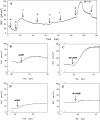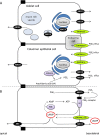Transporter function and cyclic AMP turnover in normal colonic mucosa from patients with and without colorectal neoplasia
- PMID: 22734885
- PMCID: PMC3457850
- DOI: 10.1186/1471-230X-12-78
Transporter function and cyclic AMP turnover in normal colonic mucosa from patients with and without colorectal neoplasia
Abstract
Background: The pathogenesis of colorectal neoplasia is still unresolved but has been associated with alterations in epithelial clearance of xenobiotics and metabolic waste products. The aim of this study was to functionally characterize the transport of cyclic nucleotides in colonic biopsies from patients with and without colorectal neoplasia.
Methods: Cyclic nucleotides were used as model substrates shared by some OATP- and ABC-transporters, which in part are responsible for clearance of metabolites and xenobiotics from the colonic epithelium. On colonic biopsies from patients with and without colorectal neoplasia, molecular transport was electrophysiologically registered in Ussing-chamber set-ups, mRNA level of selected transporters was quantified by rt-PCR, and subcellular location of transporters was determined by immunohistochemistry.
Results: Of four cyclic nucleotides, dibuturyl-cAMP induced the largest short circuit current in both patient groups. The induced short circuit current was significantly lower in neoplasia-patients (p = 0.024). The observed altered transport of dibuturyl-cAMP in neoplasia-patients could not be directly translated to an observed increased mRNA expression of OATP4A1 and OATP2B1 in neoplasia patients. All other examined transporters were expressed to similar extents in both patient groups.
Conclusions: OATP1C1, OATP4A1, OATP4C1 seem to be involved in the excretory system of human colon. ABCC4 is likely to be involved from an endoplasmic-Golgi complex and basolateral location in goblet cells. ABCC5 might be directly involved in the turnover of intracellular cAMP at the basolateral membrane of columnar epithelial cells, while OATP2B1 is indirectly related to the excretory system. Colorectal neoplasia is associated with lower transport or sensitivity to cyclic nucleotides and increased expression of OATP2B1 and OATP4A1 transporters, known to transport PGE(2).
Figures







References
-
- Andersen V, Ostergaard M, Christensen J, Overvad K, Tjonneland A, Vogel U. Polymorphisms in the xenobiotic transporter Multidrug Resistance 1 (MDR1) and interaction with meat intake in relation to risk of colorectal cancer in a Danish prospective case-cohort study. BMC Cancer. 2009;9:407. doi: 10.1186/1471-2407-9-407. - DOI - PMC - PubMed
Publication types
MeSH terms
Substances
LinkOut - more resources
Full Text Sources
Medical

